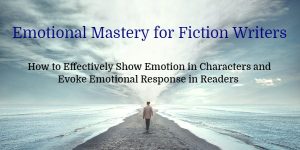Masterful Telling of Emotion
Today’s guest post is by Nina Schuyler. It continues our look at masterful writing, introducing the element of emotional content in our novels. The craft of not only expressing emotion in our characters but also evoking emotion in our readers is one of the most important things to master in fiction writing. In this post, Nina Schuyler shows us that telling about emotions can be just as powerful as showing those emotions in your characters.
Early on, when I was young and innocent and studying writing, it was vigorously pounded in my head that I must never ever tell a character’s emotion. T. S. Eliot’s “objective correlative” entered the conversation (events, objects, and actions must stand for or correlate to the desired emotion), along with fiction’s allure, which is to give readers an embodied experience—or as George Saunders tells storytellers, “Go forth and delight!”
But now, having read more, studied more, gotten older, I’ve encountered plenty of published works that tell the emotion. It’s right there, in big letters, winking at me—HE FELT. SHE FEELS—sad, happy, joyful, angry, embarrassed. And I do experience the told emotion. How is this possible? What’s going on?
The magic is in the way the telling is done.
- Use language that suggests one emotion, but ends up another emotion. In this passage from Fates and Furies by Lauren Groff, Lancelot, who is a playwright, is working with a collaborator, Leo, to write an opera. Leo has waited weeks to hear the music scored by Leo.
“After a bar, Lancelot closed his eyes. It was easier this way, to disembody the music. Like this, he heard the sound resolve into a soft song. Soaring and harmonious. So sweet it ached his teeth. Heat began in his stomach and radiated outward, up and down, into the throat, into the thighbones, an emotion so strange Lancelot had a hard time identifying what it was; but within a minute of Leo’s playing, Lancelot had put a name to it. Dread. He was feeling dread, pale and thick.” (p. 147)
The language in the passage suggests brilliance; the opera will be wonderful. The sound is “soaring,” “harmonious.” It’s so sweet it ached his teeth. It builds and builds, seemingly leading to elation or euphoria, or at least pleasure.
Instead, the passage upsets the reader’s expectation, causing the reader to feel surprise and, ultimately, to participate in the feeling of dread. The passage works because Lancelot wanted so badly for the music to be extraordinary, so when you finally get to dread, all the glowing diction is now seen as hyperbolic.
Here, then, is the key to telling. In this example and the ones that follow, surprise is critical.
Research shows when someone is surprised, dopamine increases and emotions intensify up to 400 percent. Heightened attention ensues, and so does extreme curiosity, in an attempt to figure out what is happening during the surprise.
Surprise also causes a shift—it forces a change in perspective. Your reader is hyper alert, curious, in the moment, a perfect state to tell the unexpected emotion and have the reader feel it.
A caveat: the emotion that your character ultimately feels must be authentic. It must be true and honest to the character and the situation, otherwise your reader will feel manipulated.
- Don’t go for the first-level emotion. In this short story, “Runaway” by Alice Munro, a beloved lamb, Flora, is missing. Carla loves this lamb, but she’s also lied to her husband, creating tension between them.
“It was almost a relief, though, to feel the single pain of missing Flora, of missing Flora perhaps forever, compared to the mess she had got into concerning Mrs. Jamieson, and her seesaw misery with Clark. At least Flora’s leaving was not on account of anything that she—Carla—had done wrong.”
Clara feels the singular pain of missing Flora, maybe forever, and it’s a relief. Munro didn’t stop at the pain of losing Flora. She explored the emotional layers of Carla and the situation to uncover the unexpected emotion of relief too. To get to that second, third level of emotion, you’ll need to deeply understand your character in that moment.
A good technique to use is to ask—what else is the protagonist feeling? And what else? Keep going until you get beneath the first, second, or third level of emotion.
- Turn the emotion into a metaphor or simile. This is another way into surprise, by comparing the emotion to something else. In the novel Netherland by Joseph O’Neill, the narrator’s wife leaves him and moves to London. The narrator, who lives in New York, visits on the weekend. In this passage, the narrator’s estranged wife is driving him to the airport.
“Each of her soothing utterances battered me more grievously than the last—as if I were traveling in a perverse ambulance whose function was to collect a healthy man and steadily damage him in readiness for the hospital at which a final and terrible injury would be inflicted.” Netherland, p. 189-190
O’Neill uses an extended simile (as if) and freshens the feeling of being battered by comparing it to a perverse ambulance. It’s original, it’s interestingly new, and the reader shifts her perspective, experiencing battering in a new way.
T. S. Eliot’s objective correlative is not dead. But the telling of emotion no longer feels sinful to me. Rather, it’s another technique to help readers emotionally engage with your characters. Another way for storytellers to generate delight.
 Nina Schuyler’s novel, The Translator, won the 2014 Next Generation Indie Book Award for General Fiction and was shortlisted for the William Saroyan International Writing Prize. Her debut, The Painting, was named a Best Book by the San Francisco Chronicle and was nominated for the Northern California Book Award. She teaches at the University of San Francisco and The Writing Room. Visit Nina at her website or on Facebook or Twitter.
Nina Schuyler’s novel, The Translator, won the 2014 Next Generation Indie Book Award for General Fiction and was shortlisted for the William Saroyan International Writing Prize. Her debut, The Painting, was named a Best Book by the San Francisco Chronicle and was nominated for the Northern California Book Award. She teaches at the University of San Francisco and The Writing Room. Visit Nina at her website or on Facebook or Twitter.
Want to master the emotional craft of fiction?
Dive into the online course Emotional Mastery for Fiction Writers!
In this course, you’ll be given tools to show emotions in your characters. You’ll be given techniques to help spark emotional response in your readers. What is going to bring it all together for you is practice. Study and practice. And you’ll have exercises in this course to help you put into practice what you learn.
There are two facets of emotion in fiction: conveying what your character is feeling and evoking emotion in your reader. We’ll look at these two facets separately and in de pth. Yet, they are intrinsically connected.
pth. Yet, they are intrinsically connected.
Emotional mastery requires writers to set up the dynamics of a scene in such a visual, textural way that readers can’t help but feel what they are meant to feel. Understanding that emotional mastery requires a twofold approach—the emotional landscape of both the character and the reader—is the first step.
Want to learn how to become a masterful wielder of emotion in your fiction? Enroll in my new online video course, Emotional Mastery for Fiction Writers.
You’ll get lifetime access to all the videos and more than three dozen downloadable assignments. And with a 30-day money-back guarantee, you have NOTHING to lose by jumping in. Sign up NOW.
This course will challenge you to become an “emotion master.” Are you ready and willing to go on this journey deep into emotional territory? If you want your characters to move your readers, take the plunge!











As always, another helpful Live Write Thrive post. The Lauren Groff passage is beautiful in an almost creepy way.
Thanks Nina for the advice on “telling” emotion. I really enjoyed #3 “Turn your emotion into a metaphor of simile”. I agree with you that metaphor is a VERY powerful way to convey a message, a deeply felt emotional feeling. I love Jospeph O’Neill’s excerpt from “Netherlands”.
“Soothing uttereances battereing me” is such a good way to introduce the metaphor of the narrator in the ambulance. Genius writing, at least in my opinion. I love the use of metaphors because they hit the reader in so many different spots. Great words of advice!
Michael,
I agree with you! A metaphor or simile invites an original way to experience the emotion, often making it tangible and sensual. Joseph O’Neill peppers “Netherland” with such metaphors. I highly recommend it!
Nina
Thank you, Priscilla! Groff’s Fates and Furies is filled with examples of telling characters’ emotions.
Quite a unique perspective to writing emotion. The passages illustrate your point well. The Lauren Groff passage bothered me though. ‘It ached his teeth’, is so wrong even if you allow poetic license. It should be ‘It made his teeth ache or his teeth ached on hearing it.’ While the writing is beautiful, the bad grammar spoiled it.
Thanks for sharing.
Summer,
Thank you for commenting! Groff is very playful with language, often subverting at every turn a reader’s expectations regarding syntax. I’d say her syntax mimics the novel as a whole, which, in the second half of the book, upends a reader’s expectations. She is using “ached” in a new way, definitely.
This is wonderful, Nina. Concise and so intriguing. I’m especially intrigued by and LOVE the idea that the element of surprise as a craft technique increases dopamine, thus heightened attention and curiosity ensues…and that it also forces a shift in perspective is critical too. I imagine this also works in nonfiction too. I’m teaching Ta-Nehisi Coates’ Between the World and Me right now, and some of my students took issue with the author suggesting, outright telling the reader, he was unaffected by the events of 9-11 (as his friend had just been killed in an unrelated tragedy and he was deeply upset about that). It’s surprising, to say the least, for an author to suggest this…and a brilliant way to get readers to really pay attention. Because what Coates goes on to explain is brilliant and thought provoking and not to be missed.
Caroline,
Thank you for sharing this.
I’m teaching a seminar right now, and I told my students the other night–if you take only one thing away from this course, take away the element of surprise. Not only at the subject level (like Coates did in your example), but at the paragraph level, the sentence level, the diction level. On and on.
Nina
Nina, as usual, explains with clarity, using excellent examples.
Thank you, Nanc!
It’s freeing to remember that we can use the direct telling of a character’s emotion as a way of getting to other layers– the not absolutely everything has to be shown and not told!
Eliza,
Thank you for your comment! There is so much emphasis (rightly so) on showing in writing books, seminars, workshops, that often what goes unexplained is telling. When can you do it? How? What is its relationship to showing? At some stage in the writing process and education, the role of telling needs to be explored. At the grand, macro level, the heart of the story can never be told, because you tread on the reader’s experience. The techniques that I talk about in this article invite the reader to experience and emotionally engage with the characters.
Nina
Thank you Nina for a fresh new look at ‘telling’ emotions— what a welcome relief.. I was just wondering how frequently it can be used in a novel. I’m not looking for a formula but would telling as in your examples be over used if a writer chose to use it once in each scene? Thanks again for an excellent article. Lois
Lois,
Thank you for asking this great question. To respond, I’m going to turn to Netherland and Fates And Furies, both of which use the techniques listed above for telling emotion throughout their novels. In my view, using it once in each scene would not be overdoing it.
Nina
It’s so great to reevaluate “rules” for craft and find, not that there is an exception to every drummed-in-our-head-craft rule but clear and specific explanation of the exceptions. I for one, appreciate when the mystery around creating solid prose is revealed and how to employ all writing elements for greatest impact.
Thanks for this post!
Mary,
Thank you for your response! I think the longer I study writing, the more I find myself searching underneath those “drummed-in-our-head-craft rules” to find the exceptions. In part, I think that’s the key to longevity of a career in writing, the very basic question: what haven’t I tried yet? The task then becomes understanding why the exception works.
Nina
Great advice, I love the excerpt from “Fates and Furries” I think a lot of us don’t delve deep enough into our characters emotions.
Thanks,
Cary